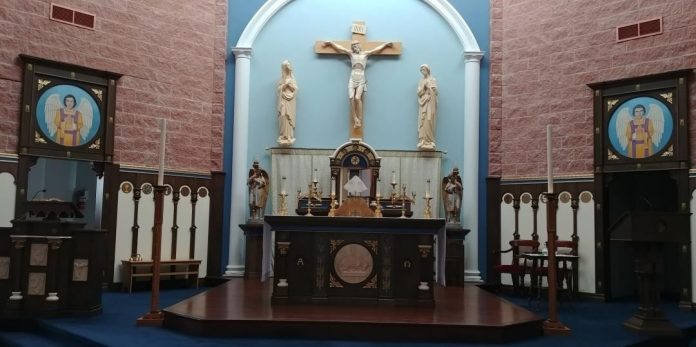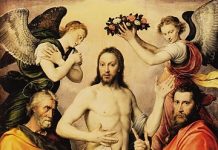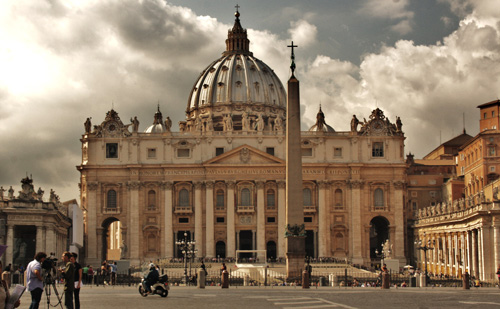‘This is my body that is for you. Do this in remembrance of me….This is the cup of the new covenant in my blood. Do this as often as you drink it, in remembrance of me.’ For as often as you eat this bread and drink the cup, you proclaim the Lord’s death until He comes (1 Cor. 11: 24-26).
This solemn celebration of the Mass of the Lord’s Supper begins the Paschal Triduum during which the Church will celebrate the greatest mysteries of the Redemption. Holy Week, Easter and the holy fifty days of the Easter season culminating in the celebration of Pentecost, all combine to spread the Easter mystery out before us in time in all its detail. In the Holy Thursday Mass three mysteries are commemorated in their detail: the institution of the Eucharist, the institution of the Priesthood, and Our Lord’s command of brotherly love. In commemorating these mysteries, we recall them; we remember them, but not in the way that we remember an event in the past as we would for example, a birthday or an anniversary. The Church uses a very specific word to describe the remembering that takes place in this sacred synaxis or assembly; the word is anamnesis. Anamnesis has the sense of recalling or re-presenting a past event so it becomes actively present.
The understanding of the Eucharist as the recalling before God of the one sacrifice of Christ in all its accomplished and effectual fullness so that it is here and now operative by it effects is clearly brought out in all traditions of the early Church. And these traditions are in keeping with the oldest written account of the Eucharistic celebration; transmitted to us by the Apostle St Paul: I received from the Lord what I also handed on to you, that the Lord Jesus, on the night he was handed over took bread….‘This is my body that is for you. Do this in remembrance of me….This is the cup of the new covenant in my blood. Do this as often as you drink it, in remembrance of me’ (1 Cor. 11: 24-25). It is to this tradition that the Church is bound at this Mass and indeed at every celebration of the Holy Sacrifice of the Mass. In the words of St. John Chrysostom, We offer even now that which was then offered, which cannot be exhausted. This is done for an anamnesis of that which was then done, for ‘Do this’ said He’, ‘for the anamnesis of Me’. We do not offer a different sacrifice like the high-priest of old, but we offer the same. Or rather, we offer the anamnesis of the Sacrifice (St. John Chrysostom in Heb hom. 17:3; quoted in Gregory Dix, The Shape of the Liturgy, p. 243). The unbroken, orthodox tradition of the Church does not deviate from the affirmation of this truth.
The words of Institution, ‘This is my Body, which will be given up for you. This is the chalice of my Blood, the Blood of the new and eternal covenant’, are not just words of a story being told or read. They are the action of Christ. For this reason the sacred liturgy is the work of God in which we participate. We do not fabricate the sacred liturgy. Through the liturgy Christ, our redeemer and high priest, continues the work of our redemption in, with and through his Church (Catechism of the Catholic Church, 1069). The understanding of this engenders a reverence for the sacred rites and for everything associated with them: the church building, the altar, the sacred vessels, and yes, even for the sacred ministers, unworthy though they be of their office. In the absence of this understanding – and sadly this ignorance is all too pervasive, the sacred rites, most especially the celebration of the Eucharist, are unlawfully and tragically altered in favour of an immediate, simple satisfaction of feelings.
In the New Testament the word ‘liturgy’ refers not only to the celebration of divine worship but also to the proclamation of the Gospel and to active charity. In all of these situations it is a question of the service of God and neighbour (Catechism of the Catholic Church, 1070). In the Mass of the Lord’s Supper, the nature and purpose of the worship we offer to God reflected in the mysteries commemorated: the celebration of divine worship in the institution of the Eucharist, the proclamation of the Gospel in the institution of the priesthood and active charity in Our Lord’s command of brotherly love. These three mysteries are interconnected; related one to the other as a unified whole; one leading to the other, distinct yet in some manner incomplete or not fully operative or effective in the absence of the others.
The mysteries commemorated this evening can also only be recognized by revelation and our knowledge of them can only deepen through faithful discipleship and an intense life of prayer. In their absence, we literally scratch the surface of our being in Christ. So we must pray this evening that we might have the courage to make our very own these words of the Apostle Paul: Indeed I count everything as loss because of the surpassing worth of knowing Christ Jesus my Lord. For His sake I have suffered the loss of all things… that I may know Him and the power of His resurrection (Phil. 3:8-10).
How is it possible for us to believe that Jesus Christ is truly present in the most Blessed Sacrament of the Eucharist – Body, Blood, Soul and Divinity – if not by divine revelation? We take Our Lord’s words at face value. Truth Himself speaks truly or there is nothing true: “This is the Body that will be given up for you; this is the Chalice of the new covenant in my Blood, says the Lord; do this, whenever you receive it, in memory of me” (1 Cor. 11: 24-25). The inability of the faithful to receive Holy Communion this evening may serve as a sacrifice of reparation for the negligence and indifference with which the Blessed Sacrament is all too often received.
As instituted by Our Lord, this Sacrament is the fruit of the Eucharist Sacrifice that can only be offered by an ordained priest. The sacrifice of Christ and the sacrifice of the Eucharist are one single sacrifice: ‘The victim is one and the same: the same now offers through the ministry of priests, who then offered himself on the cross; only the manner of offering is different.’ ‘And since in this divine sacrifice which is celebrated in the Mass, the same Christ who offered himself once in a bloody manner on the altar of the cross is contained and is offered in an unbloody manner. . . this sacrifice is truly propitiatory.’ (Catechism of the Catholic Church, 1367). This means among other things that the Eucharistic Sacrifice is more than a memorial. It is the action of Christ Himself. It is the means by which we make propitiation for our sins but also the means by which all the faithful who through Baptism share in the Priesthood of Jesus offer their praise, sufferings, prayers and work; and by means of this our offering, our lives acquire a new value. Our Lord’s sacrifice on the altar makes it possible for all generations of Christians to be united with his offering (Catechism of the Catholic Church, 1368). By what authority could a mere man, a sinful man for that matter, renew this sacrificial offering if not by the authority of Christ Himself? Yes, at the Altar, in the Confessional and in the celebration of the other sacraments the priest, a man like others yet also unlike any other, acts in persona Christi. This too is mysterious and yet it is the means by which the mercy of God is communicated to men and women through the ages and in the Eucharistic sacrifice celebrated, lived and prayed; thus the Church becomes the visible community of God’s mercy.
When he had washed their feet, and taken his garments, and resumed his place, he said to them, ‘Do you know what I have done to you? You call me Teacher and Lord; and you are right, for so I am. If I then, your Lord and Teacher, have washed your feet, you also ought to wash one another’s feet. For I have given you an example, that you also should do as I have done to you’ (Jn. 13:12-15). Our Lord’s command of brotherly love is no less a mystery since it expresses the kenotic, that is to say, the self-emptying nature of the Son of God who emptied himself and took the form of a slave, being born in the likeness of men (Phil. 2:7-8). The God who washes the feet of His disciples is also the God who was despised and rejected by men; a man of suffering and acquainted with infirmity; and as one from whom others hide their faces he was despised…wounded for our transgressions, crushed for our iniquities; upon him was the punishment that made us whole, and by his wounds we are healed (Is. 52: 15f).
This too is mysterious and this mystery of God who becomes a servant is at the heart of the mystery of the Church, the Mystical Body of Christ which in the new covenant of His Blood, the Precious Blood of the Messiah, embraces both Jews and Gentiles; and of them it makes a single people, the Church of God. This messianic people, then, that is to say the Church, though it does not in fact embrace all mankind and often seems to be a tiny flock, is yet the enduring source of unity, hope and salvation for the whole human race. It is established by Christ as communion of life, of love and of truth; it is also used by him as an instrument for the redemption of all, and is sent out into the whole world as the light of the world and the salt of the earth (Lumen Gentium, 9). This also is mysterious and we who belong to Christ are called to live and serve this mystery by living a life of intense prayer and charity, centred on the mystery of the Eucharist, the source and summit of all of the Church’s varied efforts.
The three mysteries that this Mass commemorates are indeed at the heart of the greatest mysteries of the Redemption. Tomorrow, in the Solemn Commemoration of the Lord’s Passion the truth of God’s nature will be fully revealed in the Sacrifice of the Cross; and on Easter Sunday we will renew our faith in the Risen Lord secure in the knowledge that to be in Christ is to be a new creation (Cf. 2 Cor. 5:17). The fullness of Good Friday, Easter and Pentecost is also compressed within the compass of every day’s Mass; whether a solemn and glorious High Mass or a quiet, prayerful and reverent Low Mass. Each and every Mass is the Paschal Mystery and though this Holy Thursday evening the faithful must assist at these rites from a distance, through the sacred union of prayer in mystery, we are ever mindful that whenever the memorial of this sacrifice is celebrated the work of our redemption is accomplished (Prayer over the Offerings, Holy Thursday, The Roman Missal).












